What Are the Best Saltwater Fish for Beginners?
The best saltwater fish for beginners have the following consistent attributes:
1. Select Fish That are Easy to Feed
The best saltwater fish for beginners readily takes food, typically found at your local fish store, which is important. Fish with special dietary needs can make the daily feeding regimen aggravating. It is good in the beginning to get fish that mostly eat one or two types of food to keep it simple.
2. Beginner Fish Don’t Require Unreasonable Tank Sizes
Some fish, such as tangs, can require 100-gallon tanks or larger to thrive. Most beginners don’t start with a 120-gallon saltwater tank! Don’t expect a fish recommended for a 120-gallon tank to thrive in a 30-gallon tank. It isn’t healthy, and many will say it’s cruel.
3. Beginners Need Fish That Are Hardy
You want a hardy fish that can take the beginner mistakes you will make and keep kicking. There are a lot of choices in this category, so it should be pretty easy for you to stay away from the more fragile fish.
4. Buy Saltwater Fish With a Peaceful Temperament
The best saltwater fish for beginners play well with others and are not too territorial or aggressive.
Nothing is more aggravating than having a new saltwater tank with fish problems. Fish that won’t eat or are aggressive and damaging or killing other fish can ruin the fun of owning a saltwater aquarium.
Fish temperament can vary from fish to fish of the same type! Therefore you may buy a ‘peaceful’ fish and find out that they are aggressive in certain situations such as over-crowding, not enough hiding places, too many fish in the same tank strata, etc.
The Best Saltwater Fish Help Your Tank Stay Clean
The best saltwater fish for beginners includes fish that look beautiful and provide a service for the aquarium. There are fish that can help keep the tank healthy and clean, and that helps a beginner in the hobby keep a good-looking saltwater tank.
Select Saltwater Fish That Are Reef Friendly
The last thing you want to do is buy beautiful corals for your saltwater aquarium and find your Coral Beauty Angelfish chomping polyps! This is why there are many beginner-friendly fish excluded from this Best Saltwater Fish for Beginners list!
We have included some of those maybe-not-reef-safe fish in our Best Saltwater Fish for Beginners Tier 2 list later in this article.
Free Blue Hippo Tang and Free Shipping are Available with your saltwater fish purchases for a limited time!
Best Saltwater Fish for Beginners
This is not just another stupid list of fish! It is painful to see all the Best Saltwater Fish for Beginners blog posts stuffed with as many fish as they can fit without caring whether they suit beginners. Where is the service in that?
Our list is based on experience: We have owned these fish for several years and through many saltwater and reef tanks. When I say a fish is easy to own and is worth the time and effort you will take, it is because I know it to be true.
Ocellaris or True Percula Clownfish?
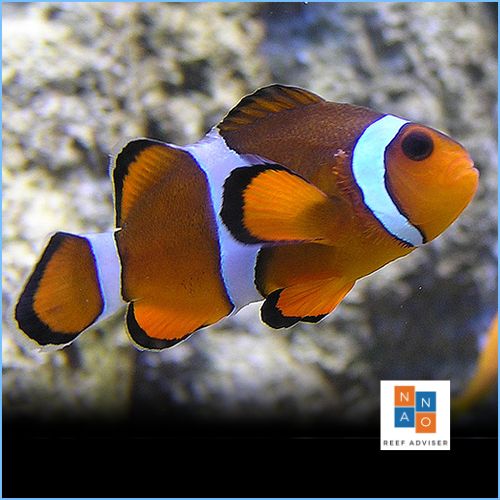
True Percula Clownfish
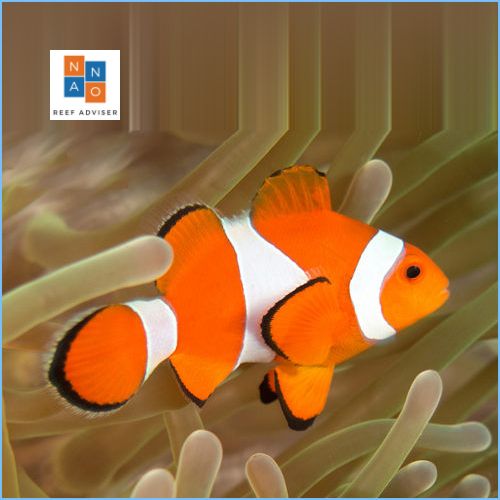
Ocellaris Clownfish
- Key Takeaway: Beautiful fish that is very hardy and easy to care for
- Recommended Tank Size: 20 gallons or larger
- Temperament: Peaceful to Semi-Aggressive (in small or overstocked tanks)
- Area of Tank: Mid to bottom
- Scientific Name: Amphiprion ocellaris / Amphiprion percula
- Care Level: Easy
- Minimum Tank Size: 20 gallons
- Diet: Omnivore
Ocellaris Clownfish (False Percula Clownfish) and True Percula Clownfish (Clown Anemonefish) are great additions to a beginner’s saltwater tank. They are hardy, easy to care for, and can be kept in pairs or small groups.
These fish are typically peaceful and will do well in a community tank with other peaceful fish. They often inhabit the mid-to-bottom area of the tank and are known for their symbiotic relationship with sea anemones.
As your clownfish grow, they may tire of your hands in the aquarium – so don’t be surprised if they try to nip at you if you get too close.
I start all of my saltwater aquariums with Clownfish! First, I find them beautiful, and second, they are very difficult to kill! Despite several unfortunate events over many tanks, I am happy to say I have never lost a clownfish. Clownfish are one of the best saltwater fish for beginners.
Saltwaterfish.com has a great selection of discounted clownfish!
If you choose to add a clownfish and you think you might want two – it is critical that you add them at the same time.
NanoReefAdviser
If added separately, clownfish are likely to be aggressive towards each other without end.
I recommend getting tank-raised clownfish, as they are relatively easy to find. Purchasing a young pair increases their chances of becoming mated pairs without the usual mating ritual struggles seen in other clownfish species. Plus, tank-raised fish are used to eating hand-fed foods and adapting well to new environments.
Firefish Goby (Fire Dartfish )
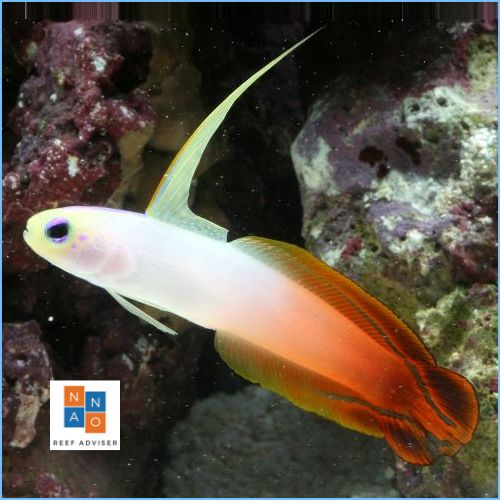
Firefish Goby (Fire Dartfish )
- Key Takeaway: Beautiful fish that is very hardy and easy to care for
- Recommended Tank Size: 30 gallons or larger
- Temperament: Peaceful
- Area of Tank: Mid to bottom
- Scientific Name: Nemateleotris magnifica
- Care Level: Easy
- Minimum Tank Size: 20 gallons
- Diet: Carnivore
Firefish Gobies are small and colorful fish that are popular among beginning aquarists. They have a mostly yellow body with a red-orange head and blue accents on the fins. Firefish Gobies are peaceful and do well in a community tank with other peaceful fish. They prefer to inhabit the mid to top area of the tank and are quick to find a hiding place when danger lurks.
Organize your aquascape to provide hiding spots for your fish, like the Firefish, that need hiding places. My experience with many fish of the Goby family is that they will jump out of the tank if startled- so make sure your aquarium has a cover!
Yellow Coris Wrasse
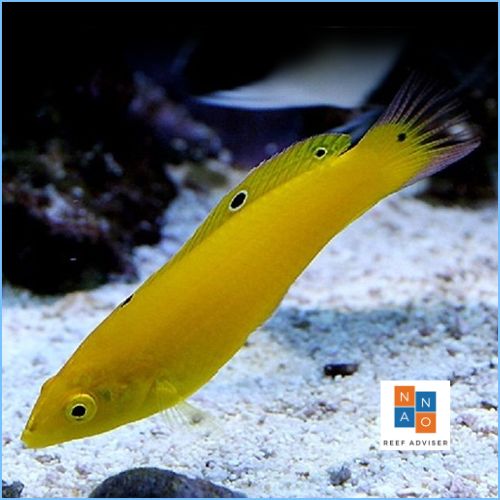
Yellow Coris Wrasse
- Key Takeaway: Vibrantly colored, sleeps in the sand bed; and is utilitarian.
- Recommended Tank Size: 50 gallons or larger
- Temperament: Peaceful to Semi-aggressive
- Area of Tank: Mid to bottom
- Scientific Name: Nemateleotris magnifica
- Care Level: Easy
- Minimum Tank Size: 50 gallons
- Diet: Carnivore
These fish are great for keeping your tank clean, as they love to eat fireworms and pyramidellid snails, which can harm corals and clams. To make it feel like home, add lots of live rock for hiding and exploring, and leave some open space for swimming. Don’t forget a 2-3 inch sandy substrate for burrowing!
The Yellow Wrasse will sleep in the sandbed and retreat to the sandbed when startled. Don’t be surprised if your Wrasse disappears for DAYS when first added to the tank, as they like to hide initially until they feel comfortable in their new surroundings.
The Coris Wrasse will do fine with other peaceful Wrasse family members.
Royal Gramma Basslet
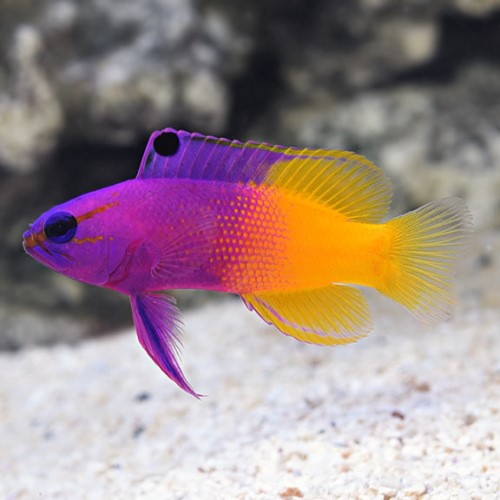
Royal Gramma Basslet
- Key Takeaway: Beautiful fish that is peaceful toward tankmates
- Recommended Tank Size: 30 gallons or larger
- Temperament: Peaceful
- Area of Tank: Mid to bottom amongst rockwork
- Scientific Name: Gramma loreto
- Care Level: Easy
- Minimum Tank Size: 30 gallons
- Diet: Carnivore
The Royal Gramma Basslet is an affordable and colorful addition to any saltwater aquarium, making it an ideal choice for first-time saltwater fish enthusiasts. This small, vibrant fish is perfect for nano reef systems and enjoys hiding in rockwork under somewhat subdued lighting.
The Royal Gramma is peaceful with tankmates and adapts quickly to aquarium life. You will want to have only one Royal Gramma per tank because they are aggressive against their own kind.
Ensure you don’t mistake the more aggressive Royal Dottyback for a Royal Gamma!
NanoReefAdviser
Lawnmower Blenny
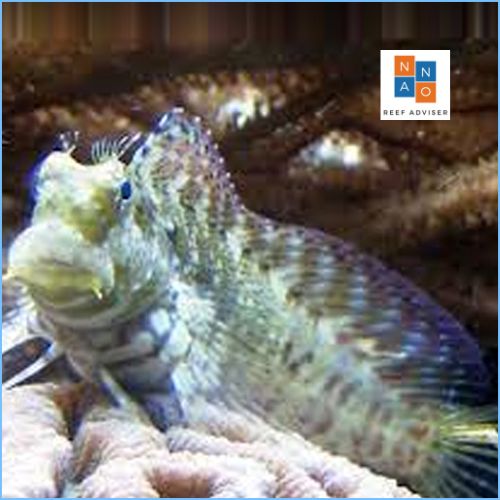
Lawnmower Blenny
- Key Takeaway: Unique-looking fish that eats algae
- Recommended Tank Size: 50 gallons or larger
- Temperament: Peaceful
- Area of Tank: Mid to bottom perching on rockwork and substrate
- Scientific Name: Salarias fasciatus
- Care Level: Easy
- Minimum Tank Size: 30 gallons
- Diet: Carnivore
The Lawnmower Blenny is a great starter fish for new aquarium enthusiasts, thanks to their beneficial role as “algae blennies.” However, since these herbivores naturally graze on algae growing on rocks and other surfaces, they should be housed in at least somewhat-established tanks with algae.
With long, slender bodies, Blennys look like tiny eel-like fish with sail fins and mainly live around rocks and the bottom part of the aquarium. Once they feel at home, they’ll swim around searching for algae to eat.
The Lawnmower Blenny has a light brown/tan color. The fish has unique “tassels” above their eyes called cirri, which help them detect predators.
Since they eat naturally growing algae, having one Blenny for every 30-50 gallons of tank space is best to ensure they have enough food.
Banggai or Pajama Cardinalfish?
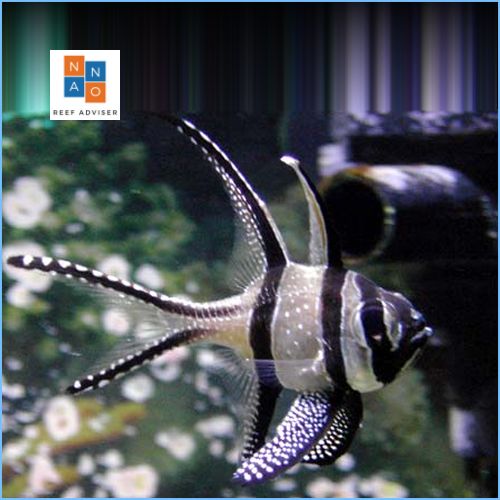
Banggai Cardinalfish
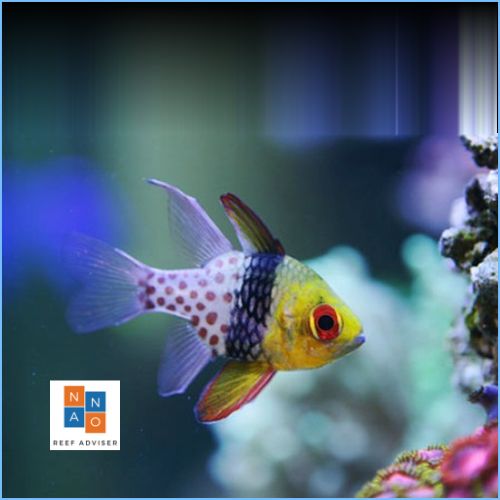
Pajama Cardinalfish
- Key Takeaway: Unique looking, peaceful schooling fish
- Recommended Tank Size: 50 gallons or more for 3 to 5 Cardinalfish
- Temperament: Peaceful to semi-aggressive (in small or overstocked tanks)
- Area of Tank: Top to Mid
- Scientific Name: Salarias fasciatus
- Care Level: Easy
- Minimum Tank Size: 20 gallons (for one Cardinalfish)
- Diet: Carnivore
Cardinalfish are unique and beautiful additions to an aquarium, with popular varieties including the Pajama and Bangaii Cardinalfish. Ideally, these peaceful fish need a 30-gallon tank, especially when kept in schools.
They’re slow swimmers and rely on hiding places and camouflage for protection, so ensure there are plenty of spots for them to hide among rocks and corals.
Cardinalfish are social and can be kept in small groups, but adjust the tank size accordingly for larger groups. Some species can even be found as captive-bred.
Yellow Tang (Yellow Surgeonfish)

Yellow Tang
- Key Takeaway: Striking yellow, active swimmer that needs room to roam
- Recommended Tank Size: 100 gallons or more
- Temperament: Semi-aggressive
- Area of Tank: Top to Mid
- Scientific Name: Salarias fasciatus
- Care Level: Easy
- Minimum Tank Size: 70 gallons (juvenile only, and you’ll have to fight the tang police)
- Diet: Herbivore (but can learn to meaty foods)
The Yellow Tang, also known as the Yellow Hawaiian Tang, Yellow Surgeonfish, or Yellow Sailfin Tang, has an oval-shaped body with a vibrant yellow color.
This active swimmer needs ample space for constant movement. Like other Tangs, it can be territorial towards its species or other Tangs, so it’s best to have only one Yellow Tang per tank unless you introduce multiple ones simultaneously.
While they will eat meaty foods, offering them plenty of seaweed and algae, including dried seaweed, is crucial to maintain a balanced diet.
These fish are expected to grow up to 8 inches as adults (not likely in captivity, but you get the idea) – so unless you plan on getting a larger tank within a couple of years, stay away from Tangs in tanks less than 100 gallons.
The “Tang Police” are aquarium hobbyists who promote proper care and housing for tang fish. They emphasize the importance of spacious tanks and optimal living conditions for these active swimmers. Their primary goal is to educate and guide the aquarium community on responsible tang fish keeping. Expect to get harassed in online forums and social media posts if you have Tangs in aquariums less than 120 gallons!
Best Saltwater Fish for Beginners, Tier Two: With Caveats
This list of beginner fish includes fish that are not quite as easy to care for or have certain quirks that make them a little more challenging for beginner aquarists.
Blue-Green Chromis
I put the Blue-Green Chromis in the 2nd tier because they require multiple feedings each day, due to their activity level, to stay at peak health. This makes them a bit of a hassle. Additionally, schools of fish take up valuable livestock space in the aquarium, and I would rather have six different kinds of fish than 6 Blue-Green Chromis in a school.
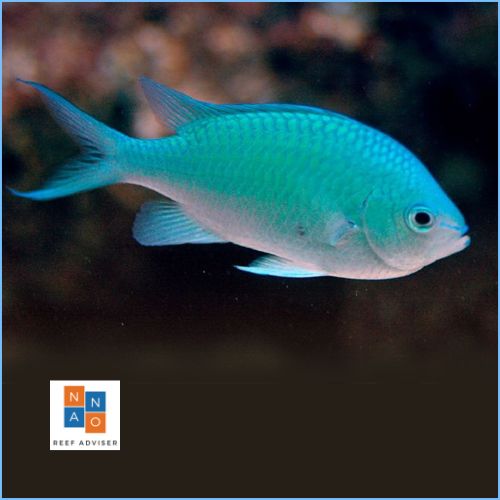
Blue-Green Chromis
- Key Takeaway: Amazing blue/green coloration, schooling fish
- Recommended Tank Size: 50 gallons or more for 6 Chromis
- Temperament: Semi-aggressive
- Area of Tank: All levels, top to mid, mostly
- Scientific Name: Chromis Viridis
- Care Level: Easy
- Minimum Tank Size: 30 gallons
- Diet: Omnivore – needs to be fed 3-5 times per day
The Blue Green Reef Chromis is popular among aquarists for its ease of care, stunning appearance, and peaceful nature. With a beautiful light blue dorsal side that fades into a pale green belly, this damselfish can coexist with most community fish, invertebrates, and corals.
In the wild, they’re found mid-depth to shallow reefs in the Indo-Pacific and South Pacific, where they school in large groups among branching corals. They thrive in similar environments and actively swim at all water levels in an aquarium.
A small school of at least six individuals adds a striking shimmer to well-established reef systems.
Be aware that the runt of the group will likely get picked on mercilessly – potentially until death. Therefore, buying your Chromis as close to the same size and health as is practical is very important.
NanoReefAdviser
These hardy fish can live long lives in well-kept aquariums. Feed them multiple times daily with a varied diet to help maintain their vibrant colors. Some aquarists have successfully bred Blue Green Reef Chromis at home, with mature males changing to a muted yellow color when ready to nest. However, breeding requires perfect water parameters and a large, non-predatory aquarium system.
Diamond Goby
I put the Diamond Goby in the 2nd tier because they require an established tank with a sand bed full of yummy organisms to munch. So while the Diamond Goby is great for beginners, it’s a later addition to an established tank.
They are also big jumpers when startled – so expect to find yours on the floor if you don’t have a tight-fitting aquarium cover. Yes, I know this because it happened to me – twice! The last time, my daughter was the one that found my Goby on the floor – and I still have never heard the end of it.
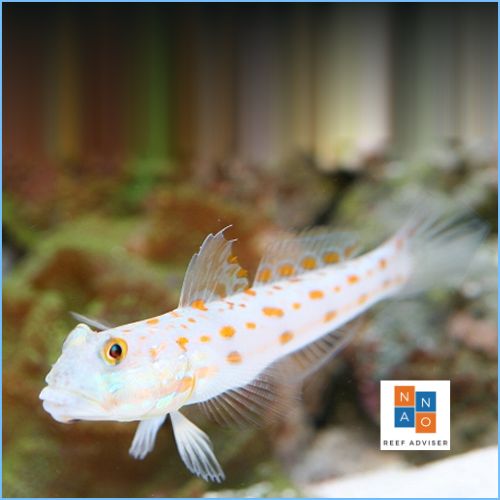
Diamond Goby
- Key Takeaway: Sand sifting and peaceful, but a jumper!
- Recommended Tank Size: 30 gallons
- Temperament: Semi-aggressive
- Area of Tank: Bottom
- Scientific Name: Valenciennea Puellaris
- Care Level: Easy
- Minimum Tank Size: 30 gallons
- Diet: Carnivore
The Diamond Goby has a large mouth for sifting through sand and filtering small organisms, which helps keep the sand bed clean and oxygenated. It usually lives in the sand, burrowing under rocks, and may rearrange your sand bed, which can be troublesome in smaller tanks.
To ensure it has enough food, maintain a live sand bed of at least 2-3 inches throughout the tank, and consider an attached refugium for extra crustaceans. You can also train the Goby to eat from a syringe or gather food in one area. Be cautious, as gobies can jump through small openings, so use a tight-fitting screen top or lid for your tank.
Coral Beauty Angelfish
The Coral Beauty Angelfish made the Best Saltwater Fish for Beginners 2nd tier because they are a little more aggressive than our recommended fish and are not guaranteed to be reef-friendly.
The degree of polyp-munching varies by individual fish – but I have had two, and they both would eat coral regardless of diet and frequency of feeding.
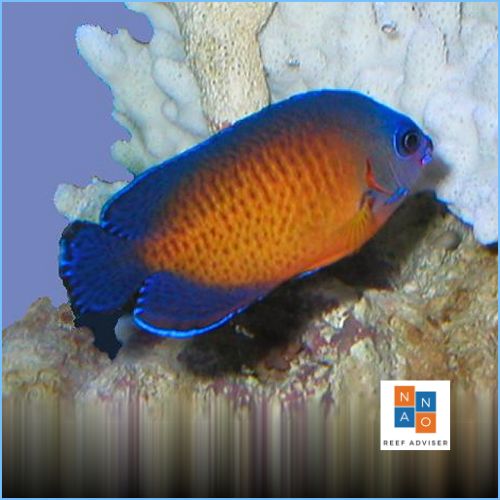
Coral Beauty Angelfish
- Key Takeaway: Stunning looker that may snack on corals
- Recommended Tank Size: 70 gallons
- Temperament: Semi-aggressive
- Area of Tank: Mid
- Scientific Name: Centropyge bispinosa
- Care Level: Easy
- Minimum Tank Size: 70 gallons
- Diet: Omnivore
Dwarf Angelfish, like Coral Beauty Angelfish, are highly valued for their stunning colors and temperament. They may nip at corals, but a well-rounded diet may help keep them peaceful in a reef tank.
These sensitive fish adapt well to aquarium life with enough space and proper nutrition. They shouldn’t be housed with other Dwarf Angelfish. Captive-bred dwarf angels are the best choice, as they’re more suited for tank life.
The Coral Beauty Angelfish, found in the Great Barrier Reef, is one of the easiest angelfish to care for. It needs a 70-gallon or larger tank with hiding places and live rock for grazing. However, it may not be suitable for reef tanks, as it can nip at stony and soft corals.
3 Safe and Easy Ways to Add Saltwater Fish to Your Aquarium
Adding fish to your saltwater aquarium can be done safely with these three simple methods:
Drip Acclimation Method
- Use a clean bucket, tubing, and something to secure the tube.
- Put the fish (in the bag or directly) into the bucket.
- Start a siphon so water drips from the tank to the bucket.
- When the bucket has twice the water, remove half and fill it again.
- Test the pH and salinity; add the fish to the aquarium if they match.
- This method is safest because it slowly mixes the water for the fish.
Floating Bag Method
- Replace 1/4 of the water in the bag with aquarium water.
- Float the bag in the aquarium, adding more aquarium water every 15 minutes.
- After an hour, use a net to add the fish to the aquarium.
- This method is riskier because it could contaminate the tank.
Bucket Acclimation Method
- Similar to the floating bag method, but done in a bucket.
- Add aquarium water to the bucket, then follow the floating bag steps.
- This method is less risky since it keeps the process away from the aquarium.
Other Saltwater Fish Tips for Beginners:
- Start with less aggressive fish and add one type at a time.
- Select fish that occupy different strata in the tank for less competition.
- Consider using a quarantine tank to check new fish for illness before adding them to your aquarium.
Related Articles for The Best Saltwater Fish for Beginners
How to Set up a Saltwater Aquarium: for acclimation and quarantine information to add fish worry-free